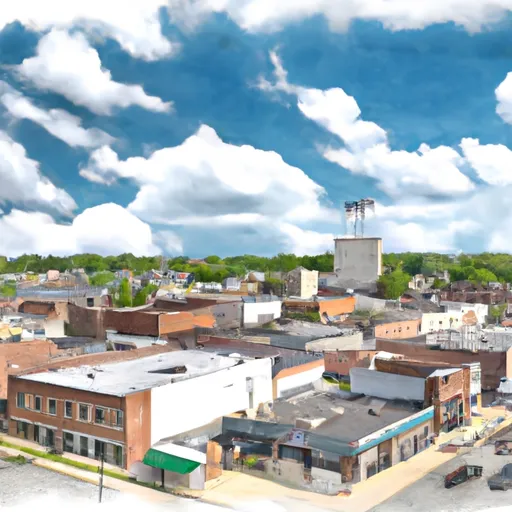-
 Snoflo Premium
Snoflo Premium
Get unlimited access to all our content
With no Ad interruptions! - Start Your Free Trial Login with existing account
Lewis
Eden Index
Climate
8.2
•
Recreation
3.4
•
Community
•
Safeguard
4.5/10

Lewis, Indiana is a charming town located in the heart of the Midwest. Known for its picturesque landscape and friendly community, Lewis offers a unique blend of natural beauty and outdoor recreation opportunities. The town experiences a moderate climate characterized by four distinct seasons. Summers are warm and humid, with temperatures averaging around 85°F, while winters are cold, with temperatures often dropping below freezing.
Lewis is blessed with an abundance of water resources, with several lakes, rivers, and streams dotting the area. The hydrology constituents are comprised of fresh, clean water that supports a diverse ecosystem and provides ample opportunities for fishing, boating, and swimming. The local rivers are especially popular for kayaking and canoeing enthusiasts, offering a scenic and tranquil experience.
Outdoor enthusiasts will find a wide range of recreational activities to engage in. The town boasts numerous hiking and biking trails, allowing visitors to explore the beautiful countryside and enjoy the stunning views. Lewis is also home to several well-maintained parks that provide opportunities for picnicking, camping, and wildlife spotting. Nature lovers can immerse themselves in the lush greenery and observe the region's unique flora and fauna.
In conclusion, Lewis, Indiana offers a welcoming community and an array of outdoor recreation opportunities. With its moderate climate, pristine hydrology constituents, and diverse landscape, the town is an ideal destination for those seeking to enjoy nature's beauty and engage in outdoor activities.
What is the Eden Index?
The Snoflo Eden Index serves as a comprehensive rating system for regions, evaluating their desirability through a holistic assessment of climate health, outdoor recreation opportunities, and natural disaster risk, acknowledging the profound impact of these factors on livability and well-being.
Climate Health Indicator (CHI): 8.2
Lewis receives approximately
1154mm of rain per year,
with humidity levels near 81%
and air temperatures averaging around
12°C.
Lewis has a plant hardyness factor of
6, meaning
plants and agriculture in this region thrive during a short period during spring and early summer. Most
plants will die off during the colder winter months.
By considering the ideal temperature range, reliable water supplies, clean air, and stable seasonal rain or snowpacks, the Climate Health Indicator (CHI) underscores the significance of a healthy climate as the foundation for quality living.
A healthy climate is paramount for ensuring a high quality of life and livability in a region, fostering both physical well-being and environmental harmony. This can be characterized by ideal temperatures, reliable access to water supplies, clean air, and consistent seasonal rain or snowpacks.
Weather Forecast
Streamflow Conditions
Patoka-White
Area Rivers
Patoka-White
Snowpack Depths
Patoka-White
Reservoir Storage Capacity
Patoka-White
Groundwater Levels
Recreational Opportunity Index (ROI): 3.4
The Recreational Opportunity Index (ROI) recognizes the value of outdoor recreational options, such as parks, hiking trails, camping sites, and fishing spots, while acknowledging that climate plays a pivotal role in ensuring the comfort and consistency of these experiences.
Access to outdoor recreational opportunities, encompassing activities such as parks, hiking, camping, and fishing, is crucial for overall well-being, and the climate plays a pivotal role in enabling and enhancing these experiences, ensuring that individuals can engage in nature-based activities comfortably and consistently.
Camping Areas
| Campground | Campsites | Reservations | Toilets | Showers | Elevation |
|---|---|---|---|---|---|
| Joe Wheeler State Park | 116 | 573 ft | |||
| Glendale State Fish and Wildlife Area | 120 | 495 ft | |||
| Montgomery Rec Park | None | 515 ft | |||
| Res 26 - Greene - Sullivan State Forest | 25 | 498 ft | |||
| Sunset City Park | None | 548 ft | |||
| David Crockett State Park | 107 | 947 ft | |||
| Greene - Sullivan State Forest | None | 521 ft | |||
| Sullivan County Park | 450 | 520 ft | |||
| Montgomery Bell State Park | 80 | 618 ft | |||
| Harpeth River Bridge | None | 393 ft |
Nearby Ski Areas
Catastrophe Safeguard Index (CSI):
The Catastrophe Safeguard Index (CSI) recognizes that natural disaster risk, encompassing floods, fires, hurricanes, and tornadoes, can drastically affect safety and the overall appeal of an area.
The level of natural disaster risk in a region significantly affects safety and the overall livability, with climate change amplifying these risks by potentially increasing the frequency and intensity of events like floods, fires, hurricanes, and tornadoes, thereby posing substantial challenges to community resilience and well-being.
Community Resilience Indicator (CRI):
The Community Resilience Indicator (CRI) recognizes that education, healthcare, and socioeconomics are crucial to the well-being of a region. The CRI acknowledges the profound impact of these elements on residents' overall quality of life. By evaluating educational resources, healthcare accessibility, and economic inclusivity, the index captures the essential aspects that contribute to a thriving community, fostering resident satisfaction, equity, and social cohesion.

